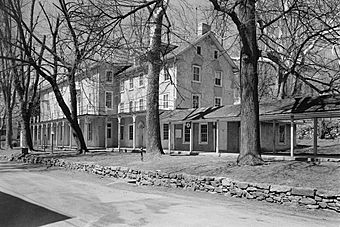Chester Springs Historic District facts for kids
The Chester Springs Historic District is a very old and special place in West Pikeland Township, Pennsylvania. It's known by many names, like The Old Art School or Yellow Springs Spa. This district is a collection of historic buildings and land that are important to American history.
It includes seven main buildings, one historic site, and one special structure. These are all part of an old spa community called Chester Springs.
Contents
What Makes Chester Springs Historic?
A historic district is a group of buildings, objects, or land that are important because of their past. The Chester Springs Historic District covers about 145 acres. It helps us understand what life was like long ago.
Buildings You Can Find Here
The district has many interesting old buildings. These include an old hotel and an inn where travelers used to stay. There are also two large homes and a bath house. This bath house was built right next to the natural springs.
A unique wooden summer house once covered the iron springs. People believed the water from these springs had healing powers.
A Place of Healing and Rest
This area has a long and interesting history. In 1777, during the American Revolutionary War, it became a hospital. The Continental Congress, which was the government of the new United States, ordered it to be built. This hospital helped soldiers who were sick or hurt.
The original hospital building was very large. It was three stories tall. Sadly, it burned down in 1902. It was rebuilt, but then it burned down again in the 1960s.
After the war, in the early to mid-1800s, the Yellow Springs area became a popular resort. People would visit to relax and enjoy the natural springs. Many of the buildings you see today were built during this time.
Why is Chester Springs Important Today?
The Chester Springs Historic District was added to the National Register of Historic Places in 1971. This means it's officially recognized as a place that is important to the history of the United States. Protecting it helps future generations learn about our past.




